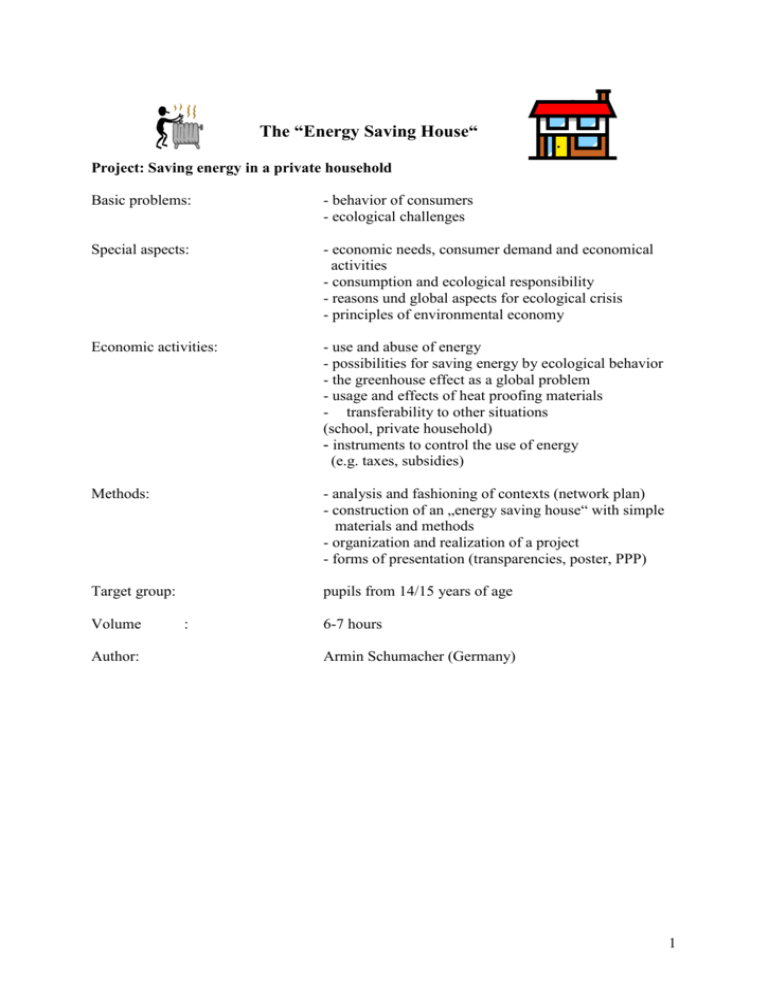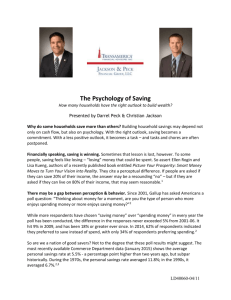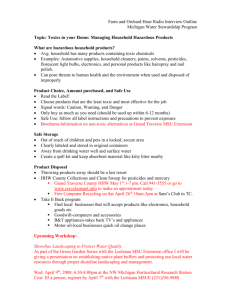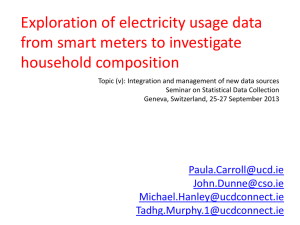Project Saving Energy
advertisement

The “Energy Saving House“ Project: Saving energy in a private household Basic problems: - behavior of consumers - ecological challenges Special aspects: - economic needs, consumer demand and economical activities - consumption and ecological responsibility - reasons und global aspects for ecological crisis - principles of environmental economy Economic activities: - use and abuse of energy - possibilities for saving energy by ecological behavior - the greenhouse effect as a global problem - usage and effects of heat proofing materials - transferability to other situations (school, private household) - instruments to control the use of energy (e.g. taxes, subsidies) Methods: - analysis and fashioning of contexts (network plan) - construction of an „energy saving house“ with simple materials and methods - organization and realization of a project - forms of presentation (transparencies, poster, PPP) Target group: pupils from 14/15 years of age Volume Author: : 6-7 hours Armin Schumacher (Germany) 1 Instructions I. Objectives of learning Pupils - recognize connections between the energy usage and the damage of the environment - demonstrate these connections with a network plan - build a house with cardboard by using a shoe box with aid of a construction plan - recognize the effects of different heat proofing materials by temperature measuring - present the results in graphic form and interpret them - calculate savings of energy costs in a private household - recognize the economic advantages of ecological behavior II. Didactical motivation from an economic view The reasonable handling of energy gets more and more important. It is possible to demonstrate with simple materials („shoe box house“) the usage and effects of heating energy in private house. It is necessary for young people to learn the handling of energy by cooperating with a local energy company. The interdependence between economic, economical and ecological behavior gets much clearer. . III. Sequence of the unit 1. Comprehension of up-to-date texts 2. Development of a network plan 3. Collecting data of energy consumption in a private household 4. Building an “energy saving house“ and conducting series of measuring 5. Presentation and interpretation of the series of measuring 6. Model calculations for a private household 7. Possibilities of transfers in school or the own house 8. Presentation of the whole project IV. Materials and literature - up-to-date texts - construction manual of the shoe box house (see worksheet) - materials of energy companies - www.sw-unna.de - consortium of energy companies – www.asew.de 2 M0 Sequence of the lessons Materials and activities for teachers and pupils 1. Brainstorming, collecting of common sayings – wall of posters 2. Up-to-date texts (M 1 - M 4) in working groups: finding important terms 3. Transfer of important terms to a network plan (M 5) 4. Consumption of energy in a private household (M 6 + M 7) 5. Building of a energy saving house in groups of 3-4 pupils (M 8 + M 9) 6. Presentation of the results as a list and as a graph (M 10) 7. Interpretation of the results: groups and in full assembly 8. Performance of the presentation: speech with transparencies, posters or PowerPoint presentation (M 11 PPP „Energies") Perhaps: continuation of the project 9. Calculating the possibilities of saving energy in the own private household (in cooperation with the local energy company) 10. Initiate projects for saving energy in your school Ml Global warming enforces storms Strong change of the climate The institute of climate research thinks that there is a connection between the hurricane “Peter" and the warming up of the earth. The west winds that are typical for the weather in Europe have increased very much in the last 25 years, so the chief meteorologist Armin Schumacher on last Monday in the West German Radio. The climate of the world is standing in a great period radical change. Extreme phases as the hurricane low of the last week with wind speeds of more than 200 km/ will become normal. The reason for this development is the warming up of the atmosphere by the greenhouse effect. Also, it would be possible that more floods (e.g. on the Rhine) happen and also more snowfalls und avalanches in the European Alps. Own Text 1 12/2007 3 M2 “Peter” was beside himself Total result after the storm of records “Peter”: crashed gondolas, blocked streets and railways and probably 25 dead people. The clearing up will take days and weeks. ”Hurricane of the death”, “Storm of murder” or “Hurricane of the century” – “Peter” made the great headlines in the press. Wind speeds of over 220 km/h were measured. Such wind speeds were never realized before. The result of that chaos: uprooted trees, destroyed electricity pylons, barred streets and railways, no railway traffic in some regions. The main highways were blocked for many hours. Police and the fire brigades had to work 24 hours a day. In Northrhine-Westfalia they counted 11 victims. The airports in Frankfort and Cologne were closed for 2 days. Many households had no electric energy for a week. Own Text 2 12/2007 M3 Does “Ötzi” announce the catastrophe of the climate? “Ötzi” is for climate scientists a mark of the coming misery. “For 5000 years this man named Ötzi lies meters deep under ice and snow and only now, in the year with the highest average temperature, he is coming to the daylight. "That could be normal" says Professor A.S. from the Peter-Brauneck-Institute of Meteorology in Soest. A.S. and other colleagues have the same opinion. They are sure that the further development of the ozonosphere is no longer under control. The glaciers in the Alps will melt away and could be no longer the reservoir of water in the summertime in Middle Europe. Own Text 3 12/2007 M4 Dramatic signal of the change of the climate. Scientists analyze the reasons of the last avalanche catastrophes in the Alps Avalanches are belonging to the winter in the Alps. But the last snow catastrophes must be put into account of the greenhouse effect, which is self made by man. The head of the Institute for the Climate-Consequences Research, Mrs. Schumacher-Gerdes, takes these findings very seriously and thinks them extremely dramatic. The air over the Atlantic Ocean is being warmer and warmer so that rain- and snowfalls will increase very heavily even in regions nobody expected. Own Text 4 12/2007 4 M5 Example of a network plan Industrialization Greenhouse gases Ozone hole Greenhouse effect Global warming Scientists Catastrophes of nature Problems Hurricanes Global warming up 25 victims Flooding Avalanches Prediction: If we don’t change it, it gets worse and worse! 5 M6 Consumption of energy in a household For which machine do we consume the most energy in our household? Icebox Mixer Warm water Illumination Washing machine Cooker Dish washer Iron Heating Drill Which 3 things consume energy in your household? Television a) the most b) the least the most the least _____________________________ ______________________________ _____________________________ ______________________________ _____________________________ ______________________________ 6 T2 Teacher information 1. Consumption of energy in a household* 52 % heating 35 % driving a car 7 % warm water 3 % so called mechanic energy, e.g. icebox 2 % production of heat by cooking or washing 1 % illumination 2. 1 kWh (Kilowatt hour) is enough for: Activity Length/Quantity* Radio 15 - 20 h Stereo 40 h Television ca. 7 h Cooking coffee ca. 70 cups Ironing 2h Using of a 150 l refrigerator Ca.3 days Washing 1 machine Cooking For 4 persons Hovering Ca. 1 h Blow dry 6-10 min Illumination 10 h or 50 h with energy saving light bulb Preparing a cake 83 cakes à 2 min with electric mixer Daily 3 times brushing ones teeth with an electric toothbrush 7 years 7 3. Consumption of electric energy by number of persons in kWh/year:* 1 - 2 pers. household 3 - 4 pers. household Illumination 200 - 290 335 - 440 Cooker 200 - 395 450 - 580 Ice box 310 - 315 420 - 425 Refrigerator 285 - 315 335 - 360 Dish washer 125 - 205 250 - 330 Washing machine 75 - 135 215 - 290 Dryer 130 - 230 330 - 470 Television 115 - 145 185 - 200 Bath with warm water 470 - 780 1080 - 1390 Machine 4. Consumption of electric energy in stand-by-activity Many machines are consuming electric energy the whole year round, because they are always in stand-by-activity Machine Computer with color monitor (14") Inkjet printer Fax Consumption/ /year in kWh* 162 123 96 Automatic answering machine 26 Color-television (Monitor 36 - 72cm) 73 Satellite dish receiver 175 - 307 Compact stereo 102 Video-recorder 101 * source: http://www.energis.de/eweb/Content/SchlauerUmziehen/UmzugInfos/energieversorg ung/energiesparen 8 M7 “The energy saving house“ Material: a shoe box - scissors, tucker, ruler, knife, adhesive film - electric cable with plug (ca. 2 m) - 30 watt light bulb (as heating source), thermometer - aluminum foil, cardboard, cork tile or similar (as heat proofing material) Construction: (s. „instruction sheet“) - cut closable windows and doors in the carton - construct a partition wall in the house - drill a little hole in the roof (thermometer) - switch on the lamp - after 2 min each read the thermometer - after ca. 12 min end of the first series a) open window - cool down the house and start a new series b) with closed windows c) with aluminum foil d) with cardboard e) with cork M8 Construction plan 1 (cardboard) 9 Construction plan 2 shoebox 10 M9 Series of measurements 11 M9 Series of measurements - The energy saving house is heated by a 30 watt light bulb Insert the thermometer through the hole in the roof, some millimeters above the ground - run 4 series of measurements: - 1. with open windows 2. with closed windows 3. with aluminum foil 4. with of cork tiles start at a temperature of 20 ° C, switch on the lamp every 2 min measure of temperature total run time of each series: ca. 12 min (between series: let it cool down!) fill the data into the list open windows closed windows with alufoil with alufoil + cork 0 min 2 min 4 min 6 min 8 min 10 min 12 min Transfer the data into a graph temperature in ° C 18 ° 0 time in min 12 M 10 A 11 Graphic illustration (example) ca. 5 series of measure (2 min each) M 11 A12 Powerpoint-Präsentation Energieprojekt Kurs10Al/Wir 2003/2004 Gesamtschule Fröndenberg Kurslehrer: Armin E. Schumacher 13








